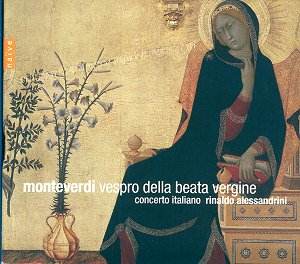Rinaldo
Alessandrini has made his international reputation largely through
performances of Monteverdi, particularly the motets, so this
new recording of the composer’s greatest choral work was bound
to be eagerly awaited. That critical opinion has been somewhat
divided should not be a great surprise. Alessandrini invites
this sort of response; his highly provocative approach to the
many historical and performing aspects being bound to divide
listeners.
In
his typically forthright sleeve-note, he tells us straightaway
that he is firmly in favour of the choir singing one to a part.
This is nothing new, of course, with Philip Pickett and Andrew
Parrott both adopting this approach. Indeed, Parrott’s excellent
super-budget version on Virgin Veritas probably provides the
main comparison for this new recording. So, if you regard the
work as a grand Renaissance choral blockbuster, best stick to
Gardiner (DG, his later version) or Jordi Savall (also Naïve)
who both use much bigger, though extremely disciplined, choral
forces to great theatrical effect.
More
controversially, Alessandrini does away with the plainsong antiphons
that most other versions adopt, and for whose inclusion there
is historical evidence. He also uses his small hand-picked choir
of twelve to vary some of the tempos, rather as Paul McCreesh
does in his similarly scaled down Bach Matthew Passion.
This works well in bringing out the dance-like origins and character
of, say, the ‘Ave Maris stella’, but some may feel that other
sections, including parts of the ‘Magnificat’ or ‘Audi caelum’
lack a certain weight or gravitas. At least Alessandrini sticks
to the now-standard published order for the work, so if you
have access to the excellent Oxford Edition, edited by Jeffrey
Kutzman (OUP, 1999) you can follow Alessandrini’s attempts at
‘authentic’ ornamentation and his unique approach to instrumentation.
Indeed,
the way the instruments, including punchy sackbuts and reedy
organ continuo, cut through the texture is one of the most exciting
things about these discs. The ‘Sonata’ floats gloriously out
in Gabrieli-style splendour, the resonant acoustic helping rather
than hindering here. Elsewhere, though mentioning individual
voices in so intimate a setup is invidious, one marvels at Monica
Piccinini and Roberta Invernizzi’s sensuous, almost operatically
ethereal ‘Pulchra es’, and the earth-shaking basses in the transposed
‘Lauda Jerusalem’.
All
in all, there is much here to be thrilled and moved by. Many
music lovers I know simply will not entertain the one-to-a-part
philosophy, but when it is done as persuasively as here, where
the sheer vocal virtuosity allows the many taxing rhythms and
quirky ornamentations to be heard with crystal clarity, then
it’s hard not to be won over. I would certainly not make it
my only Vespers, in the same way I would not make a small-scale
historically aware Beethoven 5 my only version. I would not
be without the theatrical grandeur of Gardiner or Savall (whose
mid-price version interestingly includes one Rinaldo Alessandrini
playing continuo), but there are so many details teased out
by Alessandrini that make this new version very compelling indeed.
Tony Haywood

![]() Roberta Invernizzi, Monica Piccinini, Anna Simboli (sopranos); Sara Mingardo
(contralto), Francesco Ghelardini (alto); Vincenzo di Donato, Luca Dordolo,
Gianluca Ferranini (tenors); Pietro Spagnoli, Furio Zanasi (baritones);
Antonio Abete, Daniele Carnovich (basses)
Roberta Invernizzi, Monica Piccinini, Anna Simboli (sopranos); Sara Mingardo
(contralto), Francesco Ghelardini (alto); Vincenzo di Donato, Luca Dordolo,
Gianluca Ferranini (tenors); Pietro Spagnoli, Furio Zanasi (baritones);
Antonio Abete, Daniele Carnovich (basses)![]() NAÏVE
OP.111 OP30403 [50’11 + 45’23]
NAÏVE
OP.111 OP30403 [50’11 + 45’23]





